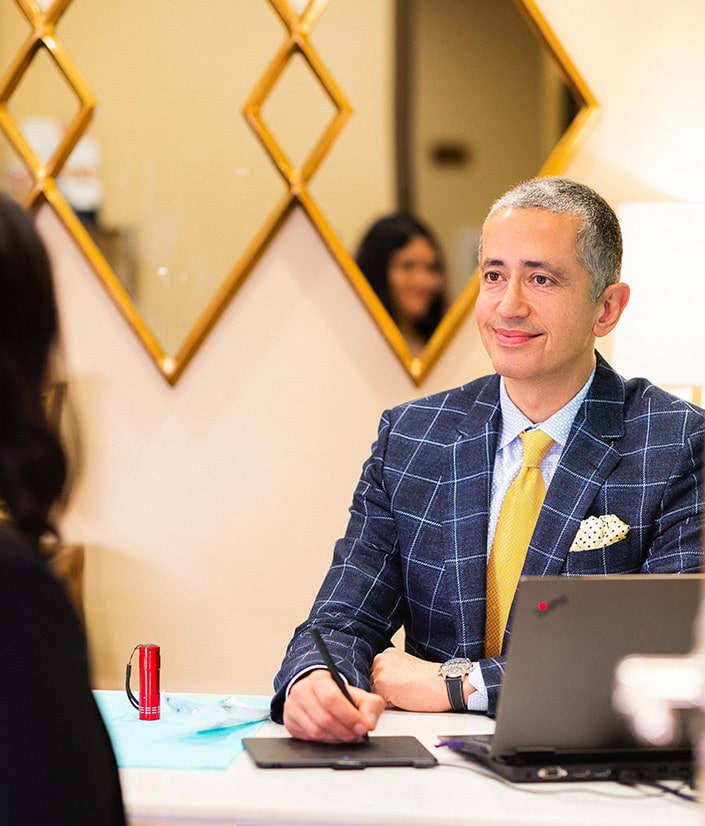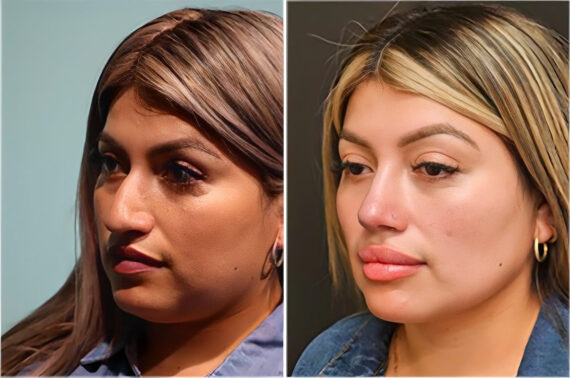By Dr. Shervin Naderi, Rhinoplasty Specialist in the Bethesda, MD, Potomac, MD, and Washington, DC area.
If you have thick nasal skin, rhinoplasty can still deliver beautiful, natural results — but it requires a different approach. From how the nose is shaped to how it heals, thick skin affects every step of the process.
At The Naderi Center, we specialize in techniques tailored to thicker skin types. This guide describes the differences in nose surgery for thick skin, and it explains how we assist patients in getting lasting, precise outcomes.

Getting a Nose Job with Thick Skin
- Thick nasal skin can hide definition, but great results are still possible with the right approach.
- A standard nose job technique won’t work; your surgeon must adjust the plan for your skin type.
- Structural grafts, careful skin management, and long-term follow-up are key to success.
- Healing needs more time, especially at the tip. The full results show after one to two years.
- Choosing an experienced rhinoplasty specialist like Dr. Naderi makes all the difference.
Understanding the Role of Skin Thickness in Rhinoplasty
For rhinoplasty, the thickness of the skin affects how the nose looks in the end. This factor is often not given enough attention. At The Naderi Center in the Washington, D.C. area, we work with many different people. More than 70 % of our rhinoplasty patients have thick skin on their noses. This is common among people who come from the Middle East, Latin America, Asia along and Africa.
For these patients, thick skin rhinoplasty requires an expert-level understanding of how the skin behaves before, during, and after surgery.
Thick Skin Is a Limitation in Rhinoplasty, But It Can Be Managed
Let’s be clear: thick skin is a limitation in rhinoplasty. It doesn’t mean you can’t have beautiful, defined results — it means we must approach your nose differently and more strategically. Thick skin can blunt or obscure the fine definition a surgeon creates in the cartilage and bone. Without proper skin management, even technically perfect work may go unnoticed.
Patients travel across the country to consult with specialists for ethnic rhinoplasty who understand the challenges and techniques specific to thick skin cases.
Why Most Surgeons Miss This Critical Detail
Unfortunately, many novice or general plastic surgeons do not fully appreciate how much skin thickness impacts outcomes. They may use the same approach on every patient, regardless of skin type. But cookie-cutter rhinoplasty doesn’t work, especially not for thick-skinned patients who require a more nuanced plan for both surgical technique and pre-/post-operative care.
Our Unique Protocol: Low-Dose Accutane Before Rhinoplasty
At The Naderi Center, one advanced plan involves giving some patients a small dose of Accutane (Isotretinoin) before their surgery. This prescription medication lowers how much oil the skin produces and also lessens the activity of oil glands. It gradually makes the nasal skin thinner and helps it drape more effectively after the structure underneath is reshaped.
This approach is especially beneficial for patients with sebaceous, oily skin or those who have previously struggled with poor definition after rhinoplasty surgery elsewhere.
Surgical Techniques During the Rhinoplasty Procedure
Thick-skinned rhinoplasty needs a specialized, structural approach. This approach helps overcome problems such as less definition, long swelling, and scars. We use advanced, structural rhinoplasty techniques specifically designed for patients with thick.
1. Structural Cartilage Grafting
Surgeons usually add cartilage instead of removing it. This cartilage supports the thicker skin and shapes the nose, especially at the tip and bridge. The grafts come from the septum, ear, or rib; this way, a person avoids forming scar tissue that can hide the nose’s shape.
2. Suture Reshaping
Rhinoplasty specialists place sutures to bend and change the nose’s cartilages without taking them out. The process refines the shape and reduces the chance of empty spots that scar tissue could fill.
3. Conservative Skin Thinning
In select cases, the fatty layer beneath the skin may be gently thinned to improve definition. However, this must be done cautiously to avoid compromising the blood supply and risking skin damage.
Both open and closed rhinoplasty techniques may be used, depending on the complexity of graft placement and the patient’s anatomy.

Trust your results to one of the nation’s top rhinoplasty specialists
Book a consultation with Dr. Shervin Naderi.
What to Expect After Rhinoplasty for Thick Skin
Recovery takes more time for patients who have thick nasal skin. Their swelling stays longer. The final definition, especially at the tip, develops gradually. Here’s a general timeline to help set realistic expectations:
Recovery Timeline
- Week 1: Cast and stitches removed. The nose appears swollen, especially at the tip.
- Weeks 2–4: Bruising fades; early swelling begins to subside. The nose may still appear round or puffy.
- Months 1–3: Subtle definition starts forming; steroid injections may be recommended.
- Months 4–6: Bridge refines. Tip swelling gradually improves.
- Months 6–12: Tip definition becomes more visible. Skin tightens over the nasal structure.
- 12–24 Months: Final results achieved. Full contour and refinement are visible.
Steroid Management to Control Rhinoplasty Swelling
After surgery, the medical team treats swelling with low-dose corticosteroids, either by mouth or through a shot. This treatment lowers swelling in places like the nasal tip, which often swells in nose surgeries that involve thick skin. When we control swelling early, the skin on the nose takes on its new form better.
Taping After Cast Removal: A Small Step with a Big Impact
Another key component of our post-operative protocol is nasal taping after cast removal. This helps flatten out swelling, guides the skin to reattach smoothly to the bone and cartilage, and prevents bulbosity in the tip. It’s a simple yet powerful technique that’s especially effective in patients with heavier skin envelopes.

Why Heat, Travel, and Sun Exposure Must Be Avoided
We advise patients to avoid long flights, especially in the early post-op weeks. Cabin pressure and prolonged immobility can worsen facial swelling. Additionally, heat is the enemy of healing — saunas, hot tubs, direct sun exposure, and hot climates can all aggravate inflammation, increase swelling, and delay final results.
Patients planning beach vacations or destination weddings should delay travel until cleared by their surgeon, particularly if they’ve had ethnic or thick skin rhinoplasty.
What Matters More Than “Reducing Stress”
While general wellness is important, we focus on tangible, physical recovery factors. We do not provide vague advice, such as “reduce stress.” Controlling sun exposure, drinking enough water, using skin products, along limiting travel affect healing and swelling. These lifestyle modifications are often the difference between a “good” and “great” result.
Why Patients with Thick Skin Choose Dr. Shervin Naderi
As one of the nation’s few rhinoplasty-exclusive facial plastic surgeons, I’ve developed a deep understanding of how to manage thick skin nose job cases with precision and care. Patients from the DMV and across the country choose our center because they know we don’t just reshape the nose — we reshape it in the context of your skin’s limitations and potential.
Our protocol is designed for realistic results, long-term refinement, and reduced frustration throughout the recovery process.

Thick Skin Can Be a Challenge, But It Doesn’t Have to Be a Barrier
Thick skin will always be a limitation in rhinoplasty, but with the right protocol and experienced hands, it doesn’t have to be a barrier to achieving your desired result. Through thoughtful planning, innovative skin management strategies, and strict postoperative guidelines, we help patients with all skin types — especially thick-skinned and ethnic rhinoplasty cases — achieve elegant, natural-looking noses.
Want to learn if you’re a candidate for thick skin rhinoplasty?
Schedule your consultation with Dr. Shervin Naderi at The Naderi Center and take the first step toward a customized, expert-level approach to your nose.
FAQs about Rhinoplasty on Thick Skin
Will my nose look smaller after surgery?
The focus on patients with thick skin often involves improving definition and shape. This differs from reducing the overall size. Reducing the size too much can cause extra scar tissue; it can also lead to bad results.
Will I need more than one surgery?
Usually no. When a specialist does the work correctly, one surgical procedure is often enough. However, post-op care and follow-up treatments like steroid injections may be part of the process.
Is ethnic rhinoplasty the same as thick skin rhinoplasty?
Not exactly, but there’s significant overlap. Many ethnic backgrounds — including Middle Eastern, Latino, Southeast Asian, and African — often present with thicker nasal skin, which requires tailored techniques.

